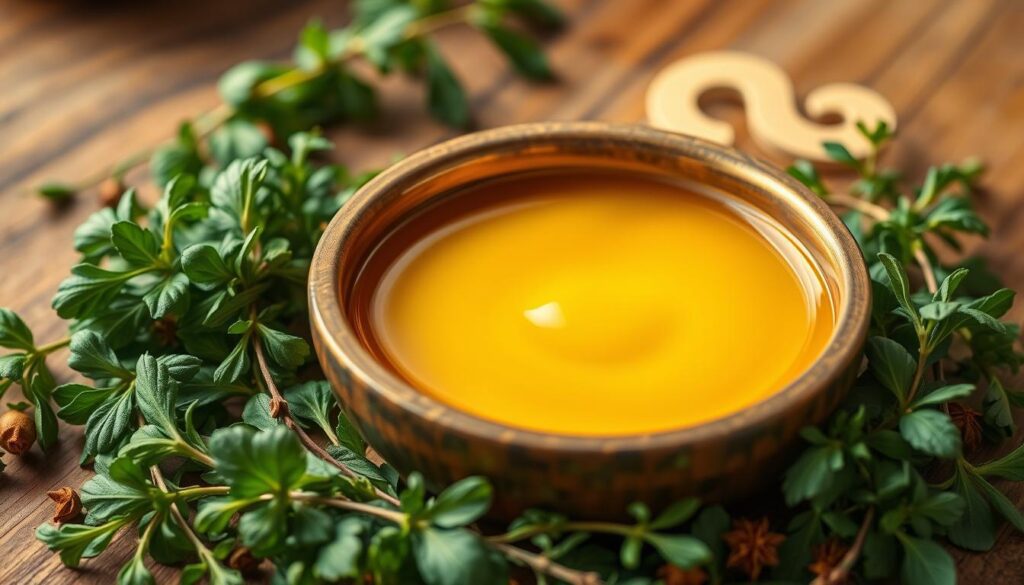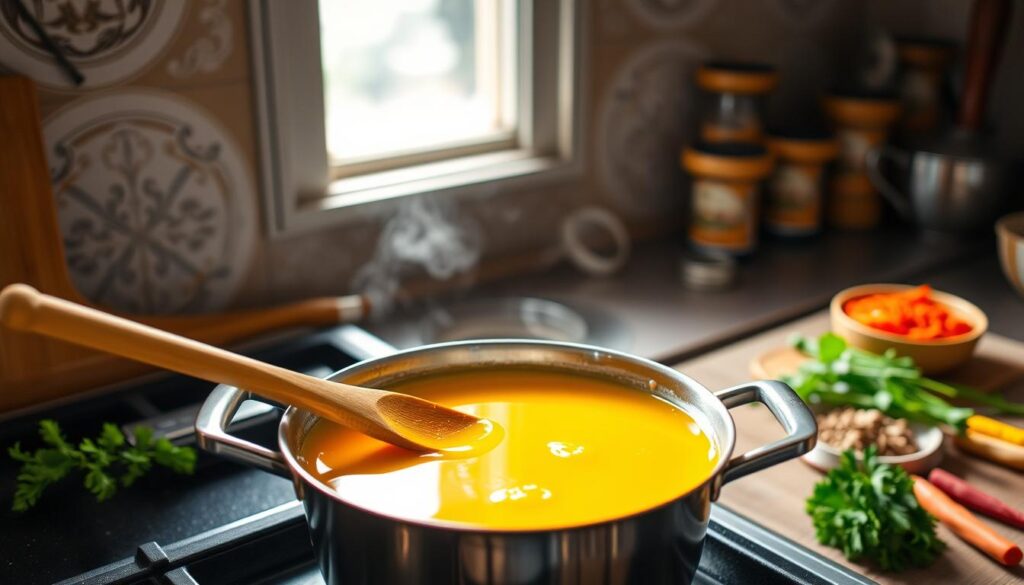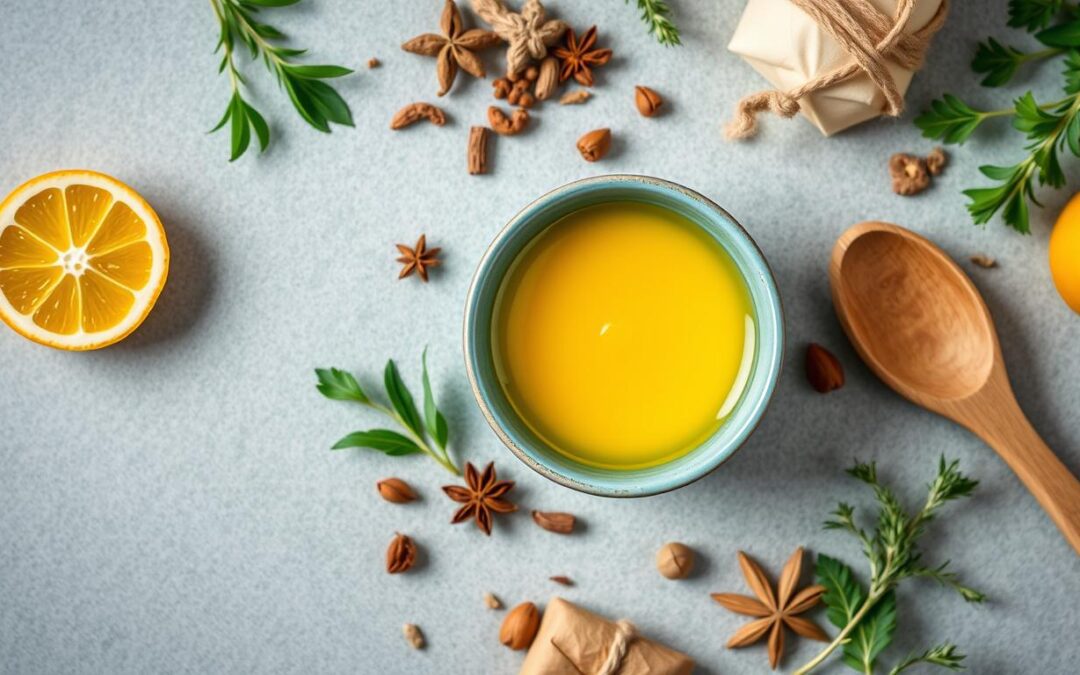Ghee is a special kind of butter from India and Pakistan. It’s loved for its taste and health perks. It is prepared by boiling unsalted butter and then separating the solids and water. This leaves a fat that’s good for you and lasts a long time.
Because it doesn’t burn easily, ghee is excellent for cooking. It has a high smoke point. It also has good fats and vitamins A, E, and K. One tablespoon has lots of vitamin A, which fights off bad stuff.
Ayurvedic medicine values ghee a lot. It’s thought to make you strong, healthy, and live longer. Today, research shows ghee might help your immune system. It could even fight off diseases like cancer and skin problems.
Ghee is mostly fat, with 112 calories in one tablespoon. It has lots of fat but not much else. Yet, it’s better than butter because it has more good fats.
Key Takeaways
- Ghee is a concentrated source of healthy fats, rich in essential fatty acids and vitamins A, E, and K.
- Its high smoke point makes it suitable for cooking at high temperatures without releasing toxic substances.
- Ayurvedic medicine has long recognized the spiritual and medicinal properties of ghee.
- Modern studies suggest ghee may boost the immune system and have a role in preventing and treating various diseases.
- While ghee has more short- and medium-chain triglycerides than butter, it also contains more saturated fat.
Page Contents
- What Is Ghee and How Is It Made?
- The Nutritional Profile of Ghee
- Ghee vs. Butter: What’s the Difference?
- Health Benefits of Ghee for Digestion
- Ghee and Heart Health
- Ghee: A Source of Energy
- The Role of Ghee in Traditional Medicine
- How Ghee Supports a Healthy Immune System
- Ghee and Weight Management
- Incorporating Ghee into Our Diet
- Common Myths About Ghee
- Conclusion: Embracing Ghee for Our Health
- FAQs
What Is Ghee and How Is It Made?
Ghee is a special clarified butter used in Indian and Ayurvedic cooking. It is made by slowly heating butter until the particles of milk, water, and fat separate. After removing the solids, you’re left with golden, nutritious ghee.
Understanding the Basics of Ghee
One tablespoon of ghee has:
| Nutrient | Amount |
|---|---|
| Calories | 130 |
| Protein | 0 grams |
| Fat | 15 grams |
| Carbohydrates | 0 grams |
| Fiber | 0 grams |
| Sugar | 0 grams |
Ghee is full of fat-soluble vitamins like vitamin E. Conjugated linoleic acid (CLA) is also high in it which may help with weight and heart health.
Traditional vs. Modern Methods of Ghee Production
Traditional ghee production includes culturing the butter first. This makes it easier to digest and balances the doshas. Modern methods might skip this step, focusing only on clarification.
Ghee is made by heating butter to eliminate water and milk solids, resulting in a pure, nutrient-dense fat that has a high smoke point and a long shelf life.
Unsalted butter is the first ingredient in homemade ghee. Simmer it over low heat until the water evaporates and the milk solids settle after gently melting it. After carefully removing the particles, use cheesecloth to filter the remaining liquid. The result is a clear, golden ghee.
The Nutritional Profile of Ghee
One kind of clarified butter that is well-known for its deep, nutty flavor is ghee. It has a unique nutritional profile. Let’s explore the nutrients in ghee and how they help our health.
Rich in Essential Fatty Acids
Ghee nutrition is rich in essential fatty acids. There are roughly 15g of fat in one tablespoon of ghee. It has 9g of saturated fat, 5g of monounsaturated fat, and less than 1g of polyunsaturated fat.
This mix of fatty acids, including omega-3 and CLA, may help our heart and reduce inflammation.
| Nutrient | Amount per tablespoon (15g) |
|---|---|
| Calories | 130 |
| Total Fat | 15g |
| Saturated Fat | 9g |
| Monounsaturated Fat | 5g |
| Polyunsaturated Fat | <1g |
| Cholesterol | 40mg |
Vitamins and Minerals Found in Ghee
Ghee is not just about fatty acids. It also has important vitamins and minerals. There are roughly 107.5 mcg of vitamin A in one tablespoon of ghee. This is about 8% of what we need daily.
Vitamin A is good for the immune system, skin, and eyes. Ghee also has vitamin E (0.4mg) and vitamin K (1.1mcg) per serving. These vitamins are key for our health.
Ghee’s unique nutritional profile, rich in essential fatty acids and vitamins, makes it a valuable addition to a balanced diet.
Even though ghee is nutritious, it’s high in calories. With 130 calories per tablespoon, eating it in moderation is important. This helps keep our diet balanced and healthy.
Ghee vs. Butter: What’s the Difference?
Ghee and butter are both great for cooking and baking. But ghee is often better because it’s healthier.
Lactose and Casein Content
To make ghee, butter is simmered until the water evaporates. The milk solids settle at the bottom and are removed. This makes ghee lactose-free, good for those with dairy allergies.
| Nutrient (per tablespoon) | Ghee | Butter |
|---|---|---|
| Calories | 120 | 102 |
| Saturated Fat | 10g | 7g |
| Monounsaturated Fat | 3.5g | 3g |
| Polyunsaturated Fat | 0.5g | 0.4g |
Ghee has slightly more calories and saturated fat compared to butter, so it’s important to use both in limited amounts. Health experts, like the American Heart Association, recommend keeping saturated fat to just 5–6% of your daily calorie intake.
According to a 2018 study involving 200 participants from North India, persons with lower cholesterol levels used less mustard oil and more ghee. Their HDL (good cholesterol) levels were greater and their LDL (bad cholesterol) levels were lower.
In conclusion, while both ghee and butter have their place in a diet, ghee may offer some heart health benefits when used in moderation.ter because it’s lactose-free and can handle high heat. But, remember to eat all fats in small amounts for a healthy diet.
Health Benefits of Ghee for Digestion

Ghee is great for your digestive system. It’s a golden liquid from ancient Ayurvedic medicine. It is good for the intestines and helps with vitamin absorption.
Promoting Gut Health
Ghee has butyrate, a fatty acid that’s good for your gut. It helps your gut’s beneficial bacteria grow. This keeps your gut healthy.
Butyrate also helps the cells in your colon. It gives them energy to fix and grow. A strong gut lining stops leaky gut and helps absorb nutrients.
Aiding Nutrient Absorption
Ghee also helps your body get more from food. Vitamins A, D, E, and K are supported by this high-fat food. These vitamins are important for strong bones, good eyes, a strong immune system, and blood to clot right.
Ghee improves the way your body uses nutrients when you eat it with food. This makes your food more nutritious.
“Ghee is a rich source of saturated fats, with one tablespoon providing about 13% of the Daily Value (DV) for vitamin A.”
Remember, ghee is high in calories and fat. But eating it in small amounts is good. It’s best to add it to a healthy diet to get its benefits without harming your health.
Ghee and Heart Health
Ghee is a key part of Indian food and is now popular in the West for its health perks. It has a lot of saturated fat, about 50%. But it also has good fats like omega-3 fatty acids that are good for the heart.
The American Heart Association says to eat less than 5-6% of daily calories as saturated fat. Yet, diets like Keto and Whole30, which use a lot of ghee, are not top choices. They are too strict, says U.S. News and World Report.
Heart-Healthy Fats in Ghee
Research shows ghee can lower bad cholesterol when eaten right. Additionally, it cooks more effectively than butter because it doesn’t burn as easily. As a result, using it for cooking is safer.
| Nutrient (per tsp) | Organic Valley Ghee | Unsalted Butter |
|---|---|---|
| Calories | 45 kcal | 34 kcal |
| Total Fat | 5g | 4g |
| Vitamin A | 4% DV | 2% DV |
Anti-Inflammatory Properties
Ghee has butyrate, which fights inflammation. However, a 2010 study found that rats eating ghee had higher triglycerides. This is not good for the heart.
“While ghee has been linked to claims of improving heart health and decreasing inflammation, there is insufficient scientific evidence to support these assertions.” – National Institutes of Health
In short, ghee may be beneficial to the heart in moderation. The Dietary Guidelines for 2015–2020 say no more than 10% of calories should be saturated fat. Eating too much ghee, like in Indian food, can lead to heart disease, says the AHA.
Ghee: A Source of Energy
Ghee is a golden elixir in Indian cuisine. It’s not just tasty but also full of energy. This clarified butter has healthy fats that give quick and lasting energy. It’s great for athletes and fitness lovers to boost their performance.

Ghee contains unique fats that the body can readily use for energy. These fats give a quick energy boost. So, ghee is perfect as a pre-workout snack or a quick energy pick-me-up.
Quick and Sustained Energy Release
The short and medium-chain fats in ghee give quick energy. Long-chain fats provide energy that lasts longer. This mix makes ghee great for long workouts and exercise.
Studies say ghee has tiny amounts of MCT oil, which might help with weight loss. It also has a bit of CLA, which could reduce fat. But, these amounts are small, so they don’t add much to health benefits.
Ghee in Athletic Performance
Athletes and fitness fans can benefit from ghee. It keeps energy steady during long workouts, avoiding crashes. The healthy fats in ghee also help with hormone balance, which is key for top athletic performance.
“Ghee has been a staple in my diet for years. As an endurance athlete, I rely on its sustained energy release to power me through long training sessions and competitions. It’s a game-changer!”
– Sarah, Marathon Runner
| Nutrient | Amount per 100g |
|---|---|
| Energy | 900 kcal |
| Total Fat | 99.5 g |
| Saturated Fat | 61.9 g |
| Monounsaturated Fat | 28.7 g |
| Polyunsaturated Fat | 3.7 g |
While ghee is rich in energy, eat it in small amounts. Saturated fat in excess is unhealthy. So, eat ghee with other healthy foods to stay balanced.
The Role of Ghee in Traditional Medicine
Ghee is a golden elixir in Ayurvedic medicine. It’s been in use for thousands of years. It’s seen as a key part of Ayurvedic practices.
Vitamins A, K2, and E, as well as linoleic acid, are abundant in ghee. It also has Omega-3 fatty acids.It’s excellent for gut and brain health.
Ayurvedic Practices and Ghee
Ayurvedic practitioners use ghee in many ways. They use it for:
- Medicated ghritams to treat imbalances, rejuvenate the body, and promote internal oleation
- Ghritams for neurological and psychiatric disorders to enhance mental health
- Ghee to promote the health of expectant and nursing mothers
- Ghee in cleansing, detoxification, and healing of wounds and skin infections
- Varying dosages of ghee for specific therapeutic purposes, such as Vāta disorders, degenerative disorders, ascites, and enhanced immunity
Historical Uses of Ghee
Ghee is also used in traditional rituals and ceremonies. It’s believed to boost physical strength and mental clarity. It’s used in cleansing rituals to remove toxins.
| Ghee Composition | Percentage |
|---|---|
| Fat | 99% |
| Saturated Fat | 60-65% |
| Short and Medium-Chain Triglycerides | 25% |
The wisdom of traditional medicine values ghee a lot. It’s used in Ayurvedic practices and in cleansing rituals. Using ghee connects us to a long tradition of healing.
How Ghee Supports a Healthy Immune System
Ghee is a golden liquid made from butter. It has been loved for its health benefits for a long time. It helps keep our immune system strong.
Vitamins A and E for Immunity
Ghee is full of vitamins A and E. These vitamins are key for a healthy immune system. Vitamin A keeps our mucous membranes strong, helping fight off sickness.
Our cells are protected by the antioxidant vitamin E. It fights off damage from free radicals. A small amount of ghee gives us a lot of vitamin E.
Antioxidant Properties of Ghee
Ghee also has lots of antioxidants. These protect our bodies from dangerous free radicals. They help reduce inflammation, making our immune system work better.
| Nutrient | Amount per 15g serving |
|---|---|
| Calories | 130 |
| Total Fat | 15g |
| Vitamin A | 107.5mcg |
| Vitamin E | 0.4mg |
| Vitamin K | 1.1mcg |
Ghee has been shown in studies to reduce the risk of heart disease and high blood cholesterol. This helps our immune system, too.
Adding ghee to our meals is a great way to boost our immune system. It’s tasty and good for us, helping our bodies fight off sickness.
Ghee and Weight Management
Ghee is a kind of clarified butter that may be useful for controlling weight. Although it is high in calories, it is also high in beneficial nutrients. These nutrients can help with weight loss when eaten in small amounts as part of a balanced diet with ghee.
Healthy Fats and Weight Loss
Medium-chain triglycerides (MCTs), which are found in ghee, aid in weight loss and fat burning.
Ghee also has omega-3 and omega-6 fatty acids. Omega-3 can help reduce belly fat in people who are overweight or obese. These healthy fats can also make you feel full and improve how your body uses insulin.
Ghee in Balanced Diets
Ghee is beneficial for controlling weight, but because it contains a lot of calories, it’s best to consume it in moderation. One tablespoon (about 14g) of ghee has:
| Nutrient | Amount per tablespoon |
|---|---|
| Energy | 123 kCal |
| Protein | 0.04g |
| Total Fat | 13.9g |
| Calcium | 0.56mg |
| Potassium | 0.7mg |
| Choline | 3.12mg |
| Vitamin A | 118µg |
| Retinol | 115µg |
| Beta Carotene | 27µg |
| Cholesterol | 35.8mg |
To not add too many calories, it’s best to limit ghee to 2 to 5 teaspoons a day. Eating ghee in a balanced diet, with exercise and managing stress, helps keep a healthy weight. Ayurveda, the traditional Indian system of medicine, recommends small amounts of ghee for healthy weight management when combined with these lifestyle factors.
Ghee can be stored at room temperature for several weeks due to the removal of milk solids, making it a suitable option for those with dairy digestive issues.
Knowing what’s in ghee and how it can help with weight loss helps us decide if we should add it to our diets. But remember, too much ghee can lead to weight gain because of its calories.
Incorporating Ghee into Our Diet
Ghee is a golden elixir with a rich history and many health benefits. It’s healthy for our bodies and excellent for cooking. Let’s examine some delectable ghee recipes and ghee cooking advice.

Delicious Recipes Featuring Ghee
Hopefully, now by so far you are aware that Ghee is a healthier alternative to butter and oil. It enhances the taste and nutritional value of many foods. Here are some tasty ideas:
- Sautéed vegetables with a dollop of ghee
- Ghee-roasted potatoes with herbs
- Stir-fried rice with ghee and spices
- Ghee-based curries and stews
Cooking Tips to Maximize Ghee Benefits
To get the most from ghee, follow these tips when cooking with ghee:
| Cooking Method | Ghee Benefit |
|---|---|
| High-temperature cooking (sautéing, roasting, frying) | High smoke point (485°F) reduces harmful compounds |
| Replacing butter or oil in recipes | Adds flavor and nutrition, good for dairy allergies or lactose intolerance |
| Consuming 1-2 teaspoons per day | Provides vitamins A and E, CLA, and butyric acid for health |
By adding ghee to our diet, we can enjoy its flavor and health benefits. Use it in ghee recipes or traditional dishes. Ghee is a great addition to our cooking.
Common Myths About Ghee
Ghee is a key part of Indian cooking, but many think it’s bad for health. They worry about its high saturated fat. Let’s look at some ghee myths and find out the truth.
Debunking Misconceptions
Many think ghee makes you gain weight. But, studies show it can help lose belly fat. It also has healthy fats like omega-3s, good for your heart.
Some believe ghee raises cholesterol. But, eating it in moderation might not raise your cholesterol much. It can actually reduce cholesterol by 10–25%.
Understanding Saturated Fats
Not all saturated fats are the same. Ghee’s fatty acids might affect health differently. It has Conjugated Linoleic Acid (C.L.A.), which helps manage weight.
| Myth | Fact |
|---|---|
| Ghee leads to weight gain | One teaspoon of ghee each day can aid in losing stubborn belly, hip, and thigh fat |
| Ghee raises cholesterol levels | Ghee can lower total cholesterol levels in the serum by 10–25% and in intestinal mucosal cells by 7–14% |
| Ghee is unsafe for cooking | Ghee has a significantly higher smoke point (around 250 degrees Celsius) compared to many oils, making it a safer cooking medium |
Ghee is also full of vitamins A, E, D, and antioxidants. It’s better than olive or groundnut oil for heart health. It has butyric acid, which boosts your immune system and helps with digestion.
Conclusion: Embracing Ghee for Our Health
We’ve talked about ghee’s benefits and how it fits into a healthy diet. It’s key to use ghee wisely. Ghee helps with digestion and heart health, but we should eat it in small amounts. There are 120 calories and 14 grams of fat in one spoonful.
Finding the Right Balance
To enjoy ghee’s benefits without harming our health, we need a balanced diet. According to experts, we should only use one teaspoon of ghee in our meals. This aids in blood sugar regulation and digestion.
Using ghee instead of regular oils adds flavor and health perks. It’s also important to pick high-quality ghee. For optimal nourishment, go for A2 milk or grass-fed cow ghee.
Ghee: A Valuable Addition to a Healthy Lifestyle
Ghee is great for our health, but it’s part of a bigger picture. A balanced diet, exercise, and stress reduction are also important. By choosing wisely and knowing ghee’s benefits, we can boost our digestion, heart health, and energy.
Let’s welcome ghee into our lives. It can make our journey to better health richer and more nourishing.
FAQs
What are the nutritional benefits of ghee?
Ghee is full of good fats like omega-3s and CLA. It also has vitamins A, E, and K. These can help your eyes, immune system, and heart.
How can ghee support digestive health?
Ghee has butyrate, a fatty acid that’s good for your gut. It helps your gut stay healthy and supports your immune system. Ghee also helps your body absorb vitamins A, D, E, and K.
Is ghee good for heart health?
Yes, ghee has good fats that are good for your heart. Eating it in a balanced diet might lower bad cholesterol. However, too much can be dangerous for your heart.
Can ghee help with weight loss?
Ghee has CLA, which might help you lose weight. But, it’s high in calories. Eating it in a balanced diet and exercising is key to staying healthy.
How can I incorporate ghee into my cooking?
Ghee is great in many dishes, from Indian recipes to modern food. Use it instead of butter or oil, but not for baking.
Is ghee suitable for people with lactose intolerance?
Ghee is a good choice for those with lactose intolerance. It’s made without most lactose and casein. But, some might be sensitive, so talk to a doctor first.
What are some of the traditional Ayurvedic uses of ghee?
In Ayurveda, ghee is seen as pure and supports strength, mind, and long life. It’s used with herbs to help them work better. It’s also used in rituals to clean the body.
Can I make ghee at home?
Yes, making ghee at home is easy. Just heat unsalted butter until it’s clear. This way, you control the quality and purity of your ghee.

